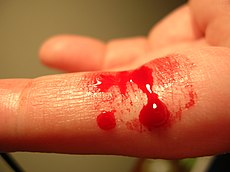
Back Bloeding Afrikaans نزف Arabic ܬܪܥܐ ܕܕܡܐ ARC دموخراجية ARY Hemorraxa AST Qanaxma Azerbaijani قاناخما AZB Pagdugo BCL Крывацёк Byelorussian Кръвоизлив Bulgarian

Bleeding, technically known as haemorrhaging (Brit.) or hemorrhaging (US) is the loss of blood or blood escape from the circulatory system.[1]
Bleeding can occur internally, where blood leaks from blood vessels inside the body, or externally, either through a natural opening such as the vagina, mouth, nose, ear or anus, or through a break in the skin.
Desanguination is a major blood loss. Exsanguination is losing enough blood to cause death.[2] A person does not have to lose all of their blood to die. People can die from losing half to two-thirds of their blood.[3]
Typically, a healthy person can endure a loss of 10–15% of the total blood volume without serious medical difficulties, and blood donation typically takes 8–10% of the donor's blood volume.[4]
The World Health Organization (WHO) established a scale to measure different degrees of blood loss, from level 0 to 4. Level 0 indicates no blood loss, whilst level 4 represents the highest level of hemorrhaging, with a risk of fatality.
- ↑ "Bleeding Health Article". Healthline. Archived from the original on 2011-02-10. Retrieved 2007-06-18.
{{cite web}}: More than one of|archivedate=and|archive-date=specified (help); More than one of|archiveurl=and|archive-url=specified (help) - ↑ "Dictionary Definitions of Exsanguination". Reference.com. Retrieved 2007-06-18.
- ↑ Mistovich, Joseph J.; Karren, Keith J.; Hafen, Brent (July 18, 2013). Prehospital Emergency Care (10th ed.). Prentice Hall. ISBN 978-0133369137.
- ↑ "Blood Donation Information". UK National Blood Service. Archived from the original on 2007-09-28. Retrieved 2007-06-18.
{{cite web}}: More than one of|archivedate=and|archive-date=specified (help); More than one of|archiveurl=and|archive-url=specified (help)